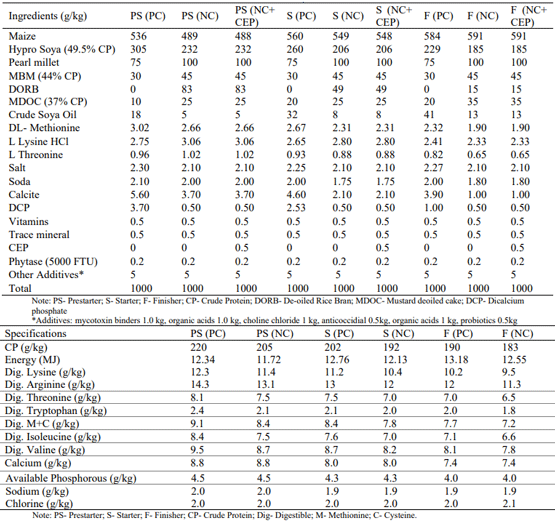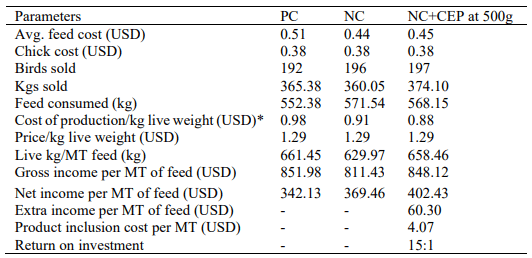I. Introduction
Feed is the largest cost in poultry production, particularly in recent times due to the increased price of protein and energy sources. Feed cost can be reduced with the inclusion of alternate protein and energy sources like pearl millet, deoiled rice bran (DORB), meat and bone meal (MBM), dried distillers’ grains with solubles (DDGS) and mustard deoiled cake (MDOC) replacing soya bean meal (SBM) and corn. However, these alternate ingredients have low digestibility and some anti-nutritional factors (ANFs) like non-starch polysaccharides (NSPs) and phytate which can have detrimental impacts on performance. In addition, birds fed with a typical corn-soy ration have approximately 1.67-1.88 MJ of metabolizable energy per kg of diet remaining undigested (Francesch et al., 2009). Inclusion of exogenous enzymes like NSPases or proteases to poultry feed is one way of addressing this issue (Lavrentiev et al., 2019) by correcting the lack of specific endogenous enzymes to digest certain nutrients or to hydrolyze ANFs in feed ingredients (O’Neill et al., 2012)
The current experiment was designed to evaluate the effect of a combo enzyme product (CEP), NUTRIKEM™ 5.0, on performance parameters (body weight, feed conversion ratio (FCR)) and the European efficiency factor which incorporates economic parameters namely livability, average weight, mean age and FCR, economic returns and gut health in commercial broilers (see footnote to Table 4). NUTRIKEM™ 5.0 is a unique combination of multi NSPase enzymes, multi protease (acid, neutral and alkaline protease) and fast acting protease embedded in a matrix of lysophospholipids. Multi NSPases improve digestion of different NSP fractions of raw materials (Khattack et al., 2006; Ravindran V 2013). Multiprotease with fast acting protease activity assists rapid protein substrate reaction throughout the intestine in a sustained manner (Chandrasekar et al., 2017). Lysophospholipids in suitable blends form a strong emulsion, better hydrolysis and absorption of lipid component and total nutrients in diets (Zhang et al., 2011). This reduces gut viscosity and improves nutrient utilization from poorly digested raw materials and bioavailability of nutrients.
II. Method
The experiment was conducted at a registered third-party trial facility (Registration number: IGNOU-38011P) in the northern part of India. A total of 600 straight run broiler chicks were randomly allocated to three dietary treatments as indicated in Table 1. Each dietary treatment had 10 replicates of 20 birds each. Table 2 represents ingredients and chemical composition of the diets.
Table 1 - Details of the treatment groups
Table 2 - Ingredients and chemical composition of experimental diets

All birds were reared in deep litter floor pens and were fed a pre-starter diet from dayone to 14 days, starter diets from 15 to 28 days, and finisher diets from 29 to 35 days. Weekly parameters pertaining to average body weight, cumulative feed intake and FCR were measured, and results were calculated after 35 days. Birds had access to ad libitum clean drinking water containing sanitizer and acidifier and were vaccinated for Newcastle disease and Gumboro disease on the 5 th and 13th day, respectively. At the end of the trial, three birds from each treatment group were sacrificed and the gut was analyzed for dysbacteriosis score as per Kemin standardized method adapted from Teirlynck, et al. (2011). Statistical analysis of the cumulative data for cumulative body weight and FCR was performed using Statgraphics Centurion XVI.II software. Data was analyzed by one-way ANOVA. A P value of > 0.05 was considered statistically non-significant. Cost of production (COP) was calculated based on the expense incurred (feed cost + chick cost) to produce final weight and average feed cost was calculated based on respective treatment formulations while chick cost was taken same for all treatment groups.
III. Results and discussion
Bird performance at day 35 is shown in Table 3. The present study revealed that the inclusion of CEP in nutrient reduced diets maintained the birds’ FCR comparable to PC. Inclusion of CEP to NC significantly reduced (P < 0.05) FCR over NC, and similar to PC with no significant difference (P > 0.05) in feed consumption among the groups. Return on investment (RoI) for CEP was expressed as ratio extra income generated per ton of feed and additional cost of the product inclusion per ton of feed. Calculation of economic benefits revealed that the addition of CEP in NC delivered RoI of 15:1 to PC group (Table 4). Gut health analysis of three birds per treatment at the end of the trial revealed that inclusion of CEP to NC provided a definite advantage by reducing dysbacteriosis when compared to PC with lowest score for dysbacteriosis among all the groups (Table 5).
Table 3 - Effect of combo enzyme product on productive performance of broilers
Table 4 - Economic benefits and return on investment
Table 5 - Impact of CEP on gut health
No statistically significant difference was observed in mortality of CEP (1.5%) when compared to PC (4%) and NC (2%). Higher EEF and lowest cost of production (CoP) were observed in CEP as compared to the other groups. As per earlier studies, dietary incorporation of enzyme systems in broiler diet improved feed conversion in nutrient reduced diets (Francesch, 2009; O’Neill et al., 2012; Coppedge et al., 2012). Various NSPase, proteases and lysophospholipids addition in NC group improved the growth performance of broilers that were similar to PC levels. This demonstrates the ability of enzymes to sustain the productive performance when dietary nutrient level was reduced. CEP displayed better control of dysbacteriosis scores which might be due to better balanced gut microflora, possibly imparted through a reduced substrate availability and microbial fermentation in the lower gut.
V. Conclusion
A combination of NSPases, multi and fast acting proteases with lysophospholipids has the potential to be an effective tool to combat rising feed costs for broiler producers. This can be achieved by incorporating CEP in diets with less digestible raw materials which helps in effective nutrient utilization. The use of CEP in the current study was able to maintain the FCR similar to PC in a nutrient reduced diet. CEP inclusion also tended to provide an economic advantage by optimizing the feed cost, lower CoP per kg broiler live weight with better gut lesion score reflecting better broiler gut health. Inclusion of CEP generated an RoI of 15:1 proving the economic viability of the product in broiler diets.
Presented at the 33th Annual Australian Poultry Science Symposium 2022. For information on the next edition, click here. 














.jpg&w=3840&q=75)